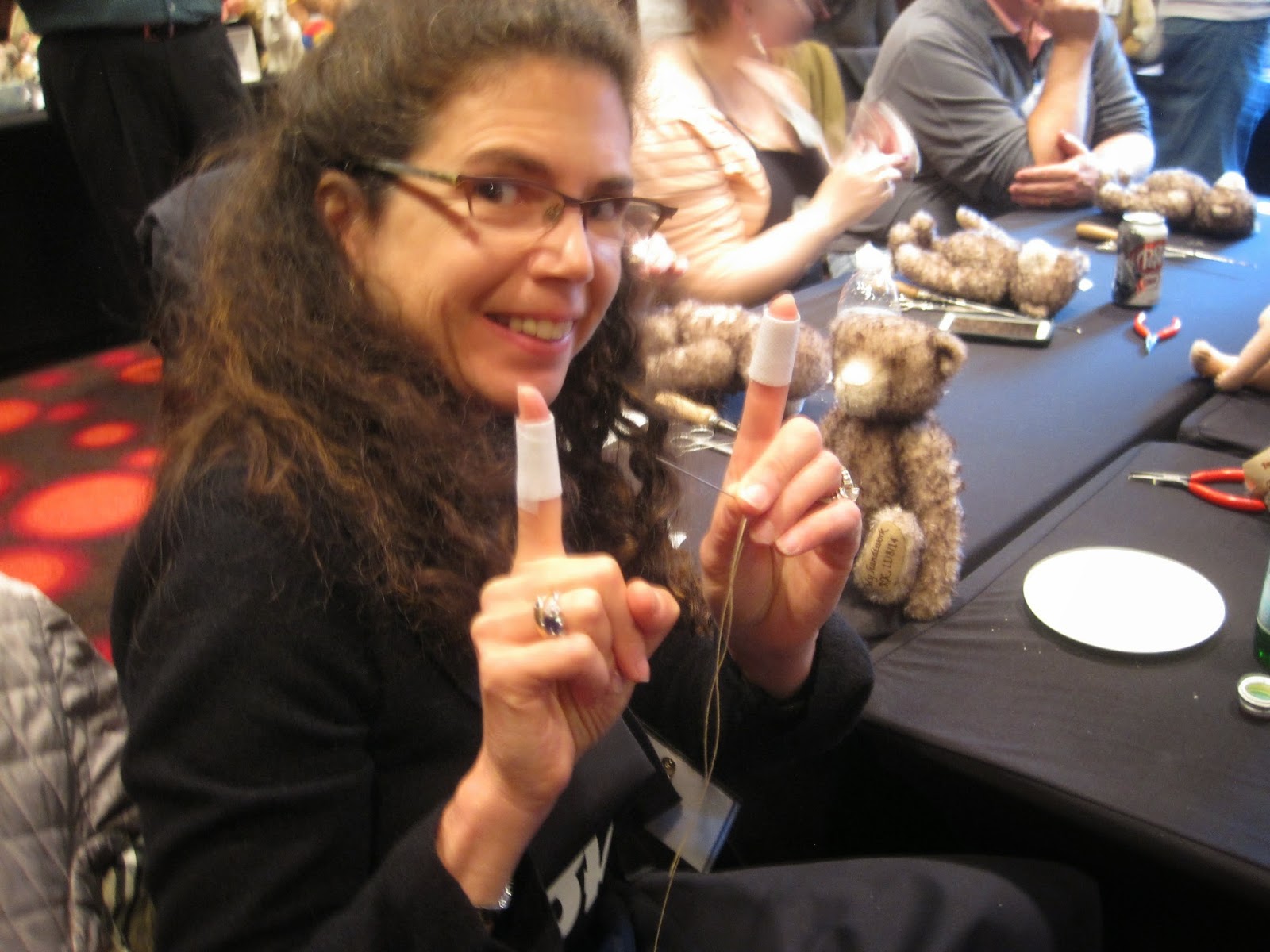 This vintage pup is the wheel-deal indeed.
Wolfspitz measures 20 cm from head to toe and 22 cm including his
wheels, measured vertically. He is standing, unjointed, and made from
tan mohair. His body and tail are made from long wavy mohair, while his
face, ears, and legs are made from matching short mohair. He has very
distinctive black hand embroidered claws on his paws, and a full and
very prominent tail. He has distinctive mohair "feathering" construction
on his front legs; this is pictured here on the left. His somewhat
serious face is detailed with black and brown glass pupil eyes, a black
hand embroidered nose and mouth, and traces of black airbrush
highlighting. He rides upon four red wooden eccentric wheels.
This vintage pup is the wheel-deal indeed.
Wolfspitz measures 20 cm from head to toe and 22 cm including his
wheels, measured vertically. He is standing, unjointed, and made from
tan mohair. His body and tail are made from long wavy mohair, while his
face, ears, and legs are made from matching short mohair. He has very
distinctive black hand embroidered claws on his paws, and a full and
very prominent tail. He has distinctive mohair "feathering" construction
on his front legs; this is pictured here on the left. His somewhat
serious face is detailed with black and brown glass pupil eyes, a black
hand embroidered nose and mouth, and traces of black airbrush
highlighting. He rides upon four red wooden eccentric wheels.  So how old is this pup, in dog years or otherwise? He
retains his short trailing "f" button and traces of his yellow year
tag. Given this utterly charming pattern was made in this size only from
1934 through 1943; his combination of IDs suggest he was produced in
the 1936 to 1943 time frame.
So how old is this pup, in dog years or otherwise? He
retains his short trailing "f" button and traces of his yellow year
tag. Given this utterly charming pattern was made in this size only from
1934 through 1943; his combination of IDs suggest he was produced in
the 1936 to 1943 time frame. Spitz, or Pomeranian dogs, are legacy patterns for Steiff. They appeared as early as 1902 in the Steiff line. The earliest Steiff Spitz dogs were produced in felt and mohair. This is most interesting from the historical perspective. And why is this? Felt was Steiff's first toy making fabric, and mohair became available on a commercially viable scale in 1903. Thus, early Spitz dogs truly embody the "old" and "new" material ways of manufacturing at Steiff!
These earliest Spitz dogs were produced in many configurations, including on wheels, sitting, fully jointed, and on a pincushion. They were made from long white curly mohair, with white felt faces, ears, and legs. All had black shoe button eyes and embroidered facial features. Most also left the factory in Giengen with a red cord with two pom-poms or tassels around his neck, giving them a “regal” appearance. The breed does have some connections to German royalty, which may explain why Steiff decorated them like “little kings.” The felt and mohair Spitz dogs appeared in the line in general through the 1920s. A typical early Steiff Spitz is pictured here on the left; the photo is from Christie's.
Except for one all mohair, 17 cm model produced from 1924 through 1927, it was not until the mid 1930's that the company focused again on Spitz dogs. In 1934, Steiff launched a series of very expressive, all mohair tan colored Spitz dogs. These included a standing version (produced in 22 and 35 cm); a sitting version (produced in 17, 21, 22, and 25 cm) and the 22 cm version on wheels, the topic of this post. At the same time, the company also introduced two new all white Zwergspitz, or Miniature Pomeranians. These included a standing model (produced in 15, 18, and 23 cm) and a 20 cm sitting version. (An example of a lovely white Zwergspitz dog is pictured here on the left, the photo is from Teddy Dorado.) All appeared in the line through 1943, when Steiff ceased toy production due to war constraints and political realities.
It is interesting to note that despite their popularity and longevity in the line, Steiff did not produce a standard line mohair Spitz after the factory reopened for business after the war in the late 1940's. More recent Spitz dogs include a 22 cm white dralon "Cosy Spitz Blanko" from 1960 through 1973; a 30 cm woven fur model produced in black, white, or red-brown from 1980 through 1983; and a 60 cm mohair standing display "Polar Pomeranian" dog, produced in 1960 and then again in 1967.
So what's in a name? According to Wikipedia, the Wolfspitz breed name was formally changed to "Keeshond," in 1926 in England. The breed is described as having "a lion like ruff, spectacles, small and dark triangular ears, definite contrast, and a thick double coat." All of these characteristics truly describe Steiff's Spitz dogs from the very beginning!
Steiffgal hopes this discussion on Steiff's lovely Spitz dogs has been a warm and fuzzy experience for you.
Have a question about one of your Steiff treasures? Let's talk! Click here to learn more.





































